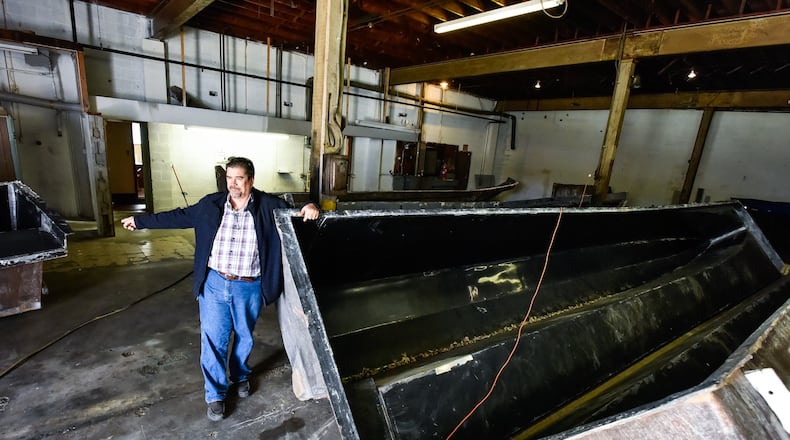Allmand’s company, Water Taxi Marine LLC, recently received a zoning change it needed to fully use its property at 1000 Forest Ave. in Hamilton’s Lindenwald neighborhood.
The company builds boats as large as 38 feet long by 12 feet wide, and it sells them for between $200,000 and $270,000. It also can build a variety of other vessels, including speedboats and yachts, with hulls of fiberglass or aluminum.
Why would a former Floridian build boats in Hamilton, Ohio?
The biggest reason he moved to Greater Cincinnati — he has been manufacturing in Hamilton County’s village of St. Bernard in recent years — was lower shipping costs, he said. His boats are transported on the tops of flatbed trucks that roll as wide loads on the highways.
“Cincinnati’s the hub of the United States” for transportation, he said. “When we were in Miami, we wanted to send a boat to New York? It’s $4,000. You want to send a boat to California? It’s $9,000.”
“In Cincinnati, it’s $3,000 to send it to Miami, it’s about $2,500 to send it to New York, and it’s about $4,000 to send it to California.”
That helps his bottom line for the large boats, which weigh about 8,000 to 10,000 pounds and are used by organizations that offer whale-watching and sight-seeing tours. The company will build 3-4 such boats per year.
Many materials, including fiberglass, come from China. Shipping of those materials also is much cheaper to here than Miami, he said.
After he bought the 10,000-square-foot building at 1000 Forest Ave. and an adjacent residential property on Forest for a combined $175,000, the city informed him he couldn’t use the residential land for commercial purposes until its zoning was changed.
“We bought this place a year ago, got ready to build boats, and were going to use the back lot, and then they informed us, ‘It’s residential. You can’t touch it,’” he said.
Now that the zoning was changed to industrial, the company will pave the former residential property and put up a pole barn or similar building on it. They also have to widen a garage door in the existing building to get boats through it.
When it is manufacturing, Water Taxi Marine regularly is visited by the U.S. Coast Guard, which watches the boat-building process and carefully examines the quality of materials used.
During the fiberglass hull-making process, workers repeatedly wax the gigantic molds for the hulls, using mold-release wax, similar to the way baking pans are greased, so the hulls easily separate from the molds when they’re finished.
Eight layers of fiberglass are used to make a hull, which typically is an inch thick.
Four workers with various skills are needed to build a boat. One must have carpentry skills, while another must have fiberglass expertise. It typically takes 12 weeks to build a hull, and another 12 to install the engine and other equipment to finish the boat.
After a boat is finished, the Coast Guard checks its stability in the harbor of an Ohio River marina, where such things as how high the boat rides above the water are measured.
“We also build them out of aluminum,” Allmand said. “Aluminum’s a little quicker.”
He’s waiting for equipment to arrive for the aluminum-boat manufacturing. Those boats can be built in parts and assembled in other places.
He had a friend from Cincinnati who was working for him in Florida and suggested the move, telling him expenses would be cheaper. Over a couple of years, he decided to move.
He also makes smaller boats, perhaps 10 a year, that can be shipped in containers atop railroad cars.
“I was building boats, but there’s less competition for water taxis, so I started doing that,” he said.
About the Author


